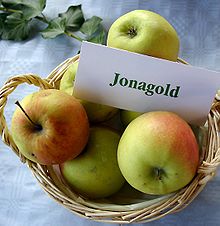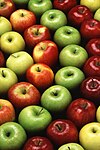Jonagold
| Malus 'Jonagold' | |
|---|---|
 | |
| Hybrid parentage | 'Golden Delicious' × 'Jonathan' |
| Cultivar | 'Jonagold' |
| Origin | Geneva, New York, USA, 1953 |

Jonagold /ˈdʒɒnəˌɡoʊld/ is a cultivar of apple which was developed in 1953 in New York State Agricultural Experiment Station of Cornell University's College of Agriculture and Life Sciences, a cross between the crisp Golden Delicious and the blush-crimson Jonathan; the name Jonagold is a portmanteau of these two variety names. They form a large sweet fruit with a thin skin. Because of their large size they are now favoured by commercial growers in many parts of the world. Jonagold is triploid, with sterile pollen, and as such, requires a second type of apple for pollen and is incapable of pollenizing other cultivars. The Apple, a sport mutation of Jonagold, was once covered under United States Patent PP05937,[1] now expired.
Jonagold has a green-yellow basic color with crimson, brindled covering colour.
The apple has a fluffily crisp fruit. It is juicy and aromatic and has a sweet-sour taste.
The skin can also turn out fully red or green other than golden-red.
It is (as of 2020) the most widely-produced apple in Belgium[2] and according to the US Apple Association website it is one of the fifteen most popular apple cultivars in the United States.[3]
Disease susceptibility[]
Descendant cultivars[]
This list is incomplete; you can help by . (February 2011) |
- (Fuji × Jonagold)
- Excel Jonagold
References[]
| Wikimedia Commons has media related to Jonagold. |
- ^ "Archived copy". Archived from the original on 2017-10-24. Retrieved 2006-10-10.CS1 maint: archived copy as title (link)
- ^ "The largest Belgian apple variety in terms of quantity is Jonagold, followed by amongst others Jonagored, Boskoop and Golden Delicious, Kanzi, Joly Red, Greenstar, etc." - retrieved October 2021 https://www.belgianfruitsandvegetables.com/en/product/fruit
- ^ Apple varieties by US Apple Association
- ^ Dr. Stephen Miller of the USDA Fruit Research Lab in Kearneysville, West Virginia.
- ^ "Powdery mildew of apples". Archived from the original on 2020-07-03. Retrieved 2021-08-15.
External links[]
- Apple cultivars with patented mutants
- American apples
- Malus stubs
- Fruit stubs
